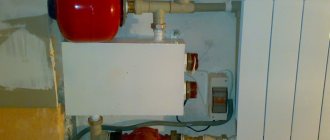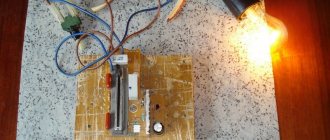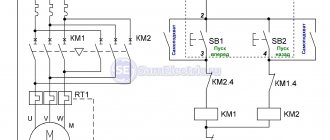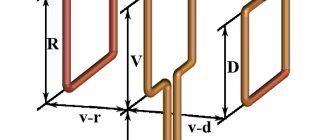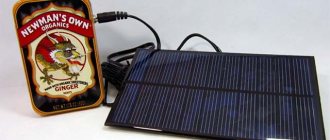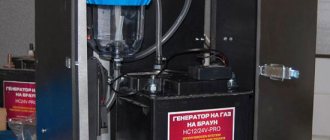Electric heating – heating a house, apartment, industrial premises using electrical heating appliances. Characterized by a wide variety of equipment used, this inexpensive type of heating has recently gained great popularity among owners of private houses and apartments.
Electric heating appliances for the home - convenience, safety, ease of operation
Advantages and disadvantages of electric heating in an apartment
Choosing a heating system for a city apartment is a complex and responsible process.
For residents of apartment buildings with central heating, the issue of heating their homes is easily resolved. It's getting cold, so wait for the heating to turn on. That category of citizens who have decided to independently take care of their own comfort is faced with a complex and difficult choice - which type of autonomous heating for an apartment in a multi-storey building to prefer. For the owner of the apartment, it is important that the system is as efficient, safe to use and economical as possible. Of all the types of autonomous home heating that exist today, all of the listed criteria are met by electric heating.
The heating season, which many of us look forward to, no longer depends on a specific date for apartments with electric heating. With the help of electricity, you can achieve an acceptable temperature in your apartment at any time, create the necessary comfort and microclimate.
Heating system installation
It is possible to positively resolve the problem - how to install heating in a private house (the diagram is given above) if you follow certain rules and the sequence of work. Installation work begins with the installation and subsequent piping of the boiler. Gas boilers with a power of up to 60 kW are installed in the kitchen. All rules for installing boilers are described in detail in the instructions for them.
Piping a heating boiler is the process of connecting the necessary equipment.
There are two ways to install a heating circuit from gas and water (metal) pipes - welding and using threaded connections. Of course, you can quickly create a system using the welding method, but it will turn out to be non-separable. By connecting the system pipes with threaded connections, you can easily change the configuration or replace any section of the pipeline at any time. For any installation method, the connection diagram for heating radiators in a private house requires special attention, and it must be drawn and calculated in advance.
Electric heating of a private house
To some extent, organizing electric heating in a private house is easier than in an apartment. The power consumption limit is much higher; it is possible to control and put in order all the wiring, starting from the power line. From the list above, a water heating system with an electric boiler is most suitable for a cottage. The reason is simple: it is necessary to ensure the use of different energy sources, and not just electricity. This means that you need to select a boiler, install it and install a one- or two-pipe system.
Currently, there are 3 types of household heat sources on the market that are used to provide electric heating for a home:
- heating elements;
- electrode;
- induction
Electrode boilers are cheaper than heating elements, but are not as well equipped. You will have to buy the circulation pump and expansion tank separately and install it yourself. So the installation of the unit as a whole will be more expensive.
Plus, you need to maintain the chemical composition of the coolant so that it contains the amount of salts necessary for the electrode heating process. And one more important point: an electrode boiler cannot operate at half capacity, but only at full capacity.
Temperature control occurs in on/off mode. The purchase and installation of an induction heat generator in a private house will require the highest costs. In terms of piping, it is similar to an electrode boiler, since it only includes a control cabinet with automation. The unit itself is reliable and durable, but has a high price.
Electrical connection
The power supply circuits are the same for all electric boilers, the only difference is the number of phases. Devices with a power of up to 12 kW are connected to a single-phase 220 V network, more than 12 kW - to a three-phase (380 V). What you will need for installation:
- power cable with copper conductors;
- differential circuit breaker or combination of RCD + conventional circuit breaker;
- ground loop.
A VVG cable of any type is used as a power line; the number of cores depends on the number of phases - 3 or 5. Select the cross-section of the current-carrying part according to the power of the heat generator, usually this parameter is indicated in the product’s operating instructions. To simplify the task, we present the data for different boilers in the form of a table.
The rating of the differential circuit breaker also depends on the power consumption of the heater; the operating current is 30 mA. For example, to protect the power line of a 3 kW (220 volt) unit, you will need a device rated at 16 A; for a power of 16 kW (380 V), you need a 32 A difavtomat. The exact ratings are indicated in the product data sheet.
To independently connect a wall-mounted electric mini-boiler room, you need to remove the front panel, run the power cable inside and connect the wires of the corresponding colors to the terminal block contacts. As a rule, the neutral wire is indicated in blue, grounding in yellow-green. The control box of the induction and electrode boiler is connected in the same way.
Electrical connections between the control cabinet and the heating block of an electrode or induction boiler are made according to the individual diagram presented in the instructions. As an example, we give a connection diagram for the popular Galan electric boiler.
Automation diagram for single-phase 220 V network
The temperature of the coolant here is monitored by overhead sensors installed on the metal sections of the supply and return pipelines. The devices are connected in series with the contacts of the thermal relay that controls the magnetic starter. When the upper temperature threshold is reached, the circuit breaks and the starter turns off the heating.
Connection diagram for connecting the boiler to a three-phase 380 V network
Suitable equipment for specific conditions
First of all, it must be said that for each specific case you need to choose the right electric heating system for your dacha. It all depends on how often you visit your country house and for what purposes it was built for you. Let's consider each of the existing situations in more detail.
Rare visit
If you visit your dacha plot extremely rarely, especially in winter, then of course there is no point in installing a capital heating system at your dacha yourself. Here it is recommended to use the connection of electric convectors, fan heaters or oil radiators. Convectors can be wall-mounted, floor-mounted, or installed on casters. Each type of design has its own advantages and disadvantages. We recommend that you immediately familiarize yourself with the tips on choosing an electric convector in order to buy the most suitable model for heating your dacha.
As for fan heaters and oil heaters, they allow you to warm up the room in the shortest possible time, which is exactly what you need for a rare visit to the dacha.
Weekend getaway
If the country house is represented by an insulated capital building, it already makes sense to make better electric heating for the country house yourself. The best solution in this case is a heated floor, which allows you to warm up the room in a short period of time and maintain a certain temperature in the house for as long as needed.
A heated floor alone may not be enough if you decide to install electric heating in a dacha with an area of 100 square meters or more. In this case, it is recommended to supplement the system by connecting infrared heaters that have high efficiency and relatively low energy consumption. A combination of heated floors and IR panels, as shown in the block diagram above, will allow you to quickly and inexpensively warm up a country house for a weekend getaway in winter.
Frequent visit
Well, the last option, which is the least common, is a country house in which the owners spend a significant part of their time. Under such conditions, it is necessary to take care of high-quality heating, and if there is no gas at the dacha, be sure to make electric heating yourself.
It is no longer rational to use equipment with high energy consumption - fan heaters and oil heaters. A more competent solution would be to connect an electric boiler operating together with water radiators.
In addition, it is recommended to connect electric heated floors in the rooms, and, if necessary, install IR ceiling panels controlled by temperature controllers. Such a dacha heating system does not require the installation of a chimney, obtaining various permits and calling a specialist for installation work, which makes it the best if there is no gas on the site.
We immediately recommend watching a video with an overview of a modern electric heating system, which in a short period of time has gained many positive reviews on the Internet:
Video review of an economical heating system for a large country house
General information
To prepare an estimate, the following documents are required:
- An exact plan of the premises where the work will be carried out. The wiring diagram must be marked on the plan.
- Customer's project with potential arrangement of electrical equipment. If it is impossible to place certain devices, the contractor will advise the customer on this topic.
- Technical conditions. This document is ordered from your electricity supplier.
- If necessary, permission to connect the circuit to the electrical network.
- Act on the balance sheet of electrical networks. Mandatory for businesses.
Important! The customer himself can provide the materials. In this case, the estimate reflects only the costs of work
In addition to materials, tools and the price of the work itself, the estimate includes:
- Increasing coefficients for certain types of work. Indicated in the Decree of the State Construction Committee dated 04/05/2004 No. 15/1. This may include work at heights, at high temperatures, in operating buildings.
- Overheads. Regulated by MDS 81-33.2004 and MDS 81-25.2001.
- VAT compensation - under a simplified taxation system. Regulated by Letter of the State Construction Committee No. NZ-6292/10 dated October 6, 2003 (For the simplified tax system, leave 20% VAT).
- Estimated profit. You can learn about it from the Letter of the State Construction Committee dated November 18, 2004 No. AP5536/06.
- Transport costs (not always).
- Unexpected expenses.
Important! If amendments are made to the estimate at the initiative of one of the parties, the other party must be notified of this. All changes and adjustments must be documented to avoid disputes in the future.
Which option is better to avoid?
We talked about cheap and effective systems for economical heating of a private home, but we would also like to point out the most expensive options that should be avoided. The top of the ranking is occupied by oil radiators. They are known to everyone for having high power, so when working in winter you can see a noticeable increase in electricity consumption.
Not only do these products have high power, but their heating efficiency is also very weak. For example, an IR panel of the same dimensions and the same power will make the house warmer faster, so it is better to give preference to it.
In addition, an infrared heater is installed on the ceiling or wall, thereby not occupying free space, which cannot be said about electric radiators.
Another not recommended option is fan heaters. These devices not only burn oxygen, but also “drive away dust” and are also noisy. The effectiveness of their use is not very high, because... between the ceiling and floor, the temperature may differ by several degrees, despite the fact that the power of the products is high (from 1.5 kW).
Filling without heating
We looked at the most common options for heating concrete, however, winter concreting can be done without heating. This method is good because it does not require the supply of electricity and the installation of heating systems, which speeds up the construction process.
The principle of this technology is to use special additives that reduce the freezing point of water, as well as speed up the hardening process of concrete so that the solution does not have time to freeze. At the same time, the strength of the material does not suffer at all.
Pouring concrete in winter without warming up - building a foundation
Among other advantages of using this technology is the prevention of efflorescence.
An example of such compositions is the Morozostop additive. To ensure frost resistance of the mixture with its help, you just need to add the required amount of the substance, which is indicated on the packaging. The price of such an additive is quite affordable, so the cost of concrete practically does not increase.
These are, perhaps, all the main nuances that you need to know about warming up concrete and pouring it in the winter if you decide to do construction at sub-zero temperatures.
Choosing the right system
Depending on the area of the living space and the quality of wall insulation, a suitable option for autonomous electric heating of the apartment is selected. If you are the owner of a one-room or two-room Khrushchev house, a heated floor system in combination with electric convectors or IR panels can cope. Combinations with infrared heaters are more profitable and efficient, because... thermal radiation will be directed from top to bottom and all the heat will circulate in the lower part of the room. Heating an apartment with electric convectors is better only because the devices do not dry the air and do not have a negative impact on human well-being. There are many reviews that IR heaters with constant radiation have a negative effect on health, which is their disadvantage.
You can find other advantages and disadvantages of infrared heaters in the corresponding article. Yet, as statistics show, in 2022 such devices are actively purchased for household use!
As for electric underfloor heating, it is indeed very popular and effective. Anyone can install a heated film floor under a laminate, even an electric kettle. In addition, the material can only be used to make heated paths in the apartment, and not to lay film over the entire floor area. This heating option will have a positive effect on energy savings and at the same time will effectively warm the room.
If you live in a three-room or four-room house, then it would be more reasonable to use the connection of electric water heating in the apartment. This is due to the large total area of the rooms, which will require a full-fledged, powerful heating system. For example, if the area is 130 sq. m., with the calculation of 1 kW/10 sq. m. it will be necessary to install no less than a 13-kilowatt bundle of electric heaters. Of course, in winter you will spend a lot of money on the operation of an individual electric heating system. In addition, to use this option, the wiring must be powerful and able to withstand high current loads. In this case, you cannot do without replacing the electrical wiring in the apartment, which, again, will hit your budget. At the same time, if you use water radiators powered by an electric boiler, the heating will be autonomous and less expensive, which will allow you to “kill two birds with one stone.”
We recommend that you immediately read the article on how to properly connect a boiler to the network with your own hands so that you don’t make mistakes and the system lasts longer!
Method 6 - electrode boiler
Inside the electrode boiler there are electrodes, which act as a heating element. When current passes through a liquid, heat is generated. This means that in electrode boilers there is no actual heating element on which scale could form. The absence of scale will greatly facilitate operation.
Electrode boilers are highly reliable and operate much longer than tubular heaters. In addition, they are small in size, which is very convenient for a small residential building. The disadvantages include high requirements for the liquid used as a coolant. Water must undergo special treatment. Often, antifreeze generally must be exclusive - from the device developer.
The photo shows an electrode boiler Galan, Russia
Electric heated floors
The most popular option for electric heating of a private home is based on the use of a heated floor system. Such heating can be organized in any room of the house, even in the bathroom.
Electric heated floors
If desired, you can opt for a “smart” model of electric heated floor. Special sensors and other automation equipment will allow the system to determine the temperature in the room and independently change the power to ensure the most comfortable conditions. Installation of such heating is carried out in several stages.
Electric heated floors
First stage. Thoroughly clean and level the base using a concrete screed.
Second phase. Place insulation and waterproofing material on the dry base.
Third stage. Lay the heated floor structure. There are several modifications. The instructions for the system you choose will provide the optimal installation scheme.
Fourth stage. Install the thermostat and other related elements, and then connect the heated floor to the mentioned electronics. Manufacturers provide recommendations for the placement of all mechanisms, as well as their connection to each other, in the instructions for their products.
Fifth stage. Pour the concrete screed and wait until it dries.
Sixth stage. Apply the selected finishing coat to the dry screed.
Features of two-pipe circuit wiring
The two-pipe system comes in several varieties. They have a different connection diagram for heating radiators in a private house, and a different vector of coolant movement.
In small private houses, the following types of two-pipe heating systems are used:
Brief characteristics of two-pipe systems
Dead-end system - the entire pipeline network consists of two arms (branches), one for supply and the other arm for coolant return. The movement of water occurs in counter directions.
Associated two-pipe system - the return arm serves as a continuation of the supply arm (branch), i.e. the system is looped. This heating connection scheme in a private house is deservedly popular.
Collector is the most expensive heating distribution scheme for a private house due to the need to lay pipes to each battery, and their installation is hidden.
Open "gravity" two-pipe system
Let's consider the heating system installed in a private house with our own hands; a two-pipe open circuit was selected and an open tank was installed at the top point of the circuit. The pressure that determines the speed of fluid movement in the “gravity” system depends on the height of the tank. The main advantage of a two-pipe system is that water flows to the radiators at the same temperature, and a clear separation of pipelines into supply and return makes it easier to automate control.
For successful operation of the “gravity” system, a slope of 3-5 mm/m is ensured during installation. Due to gravity, any type of heating system can operate if the necessary conditions are created - the slope of the coolant supply lines for natural circulation. It must be taken into account that the “gravity” system can only work with an open expansion tank.
Closed two-pipe system
When installing steam heating in a private house, the scheme is chosen to be closed, and its type depends on the number of floors of the building. If the house is one-story, then two pipeline branches are laid - supply and return, and heating devices are connected to them in parallel.
And in order to install the heating of a two-story private house with your own hands, the wiring diagrams must contain the required number of liquid supply branches. One branch of the collector should power the batteries on the upper floor, the second branch should power the batteries on the lower floor. The water that has given up its heat returns to the boiler through the “return”. A closed system must have a circulation pump to create pressure.
Operating principle of closed CO
A closed (otherwise known as closed) heating system is a network of pipelines and heating devices in which the coolant is completely isolated from the atmosphere and moves forcibly - from a circulation pump. Any SSO necessarily includes the following elements:
- heating unit - gas, solid fuel or electric boiler;
- safety group consisting of a pressure gauge, safety and air valve;
- heating devices - radiators or underfloor heating circuits;
- connecting pipelines;
- a pump that pumps water or non-freezing liquid through pipes and batteries;
- coarse mesh filter (dirt collector);
- closed expansion tank equipped with a membrane (rubber “bulb”);
- shut-off valves, balancing valves.
A typical diagram of a closed heating network for a two-story house.
The operating algorithm of a closed type system with forced circulation looks like this:
- After assembly and pressure testing, the pipeline network is filled with water until the pressure gauge shows a minimum pressure of 1 bar.
- The automatic air vent of the safety group releases air from the system during the filling process. He also removes gases that accumulate in pipes during operation.
- The next step is to turn on the pump, start the boiler and warm up the coolant.
- As a result of heating, the pressure inside the ZSO increases to 1.5-2 Bar.
- The increase in the volume of hot water is compensated by a membrane expansion tank.
- If the pressure rises above the critical point (usually 3 Bar), the safety valve will release excess liquid.
- Once every 1-2 years, the system must undergo an emptying and flushing procedure.
The principle of operation of an apartment building's SSS is absolutely identical - the movement of coolant through pipes and radiators is ensured by network pumps located in an industrial boiler room. There are also expansion tanks there; the temperature is regulated by a mixing or elevator unit.
How a closed heating system functions is explained in the video:
Options for electric heating of a private house
Such a heating scheme involves the use of various types of equipment.
Boiler application
It is not uncommon to install an electric boiler for heating a 220V home. This device is a budget option and is easy to install.
Electric boilers are of the following types:
The diagram shows the principle of working with heating elements
Electrode model device
Installation of induction device
Selecting IR panels
When determining how to heat a house economically with electricity, you can consider the option of installing infrared structures. Such products do not warm up the air inside the rooms, but various objects. If in the version with a boiler the air masses move upward and then cool, then in this case the hot flows are directed to the floor.
Infrared designs do not take up much space
If you add thermostats to IR devices, they will work more efficiently. One controller is enough to control three heaters. This equipment is economical to use, but expensive in terms of installation and construction costs. IR devices consume a small amount of electricity. In addition, they efficiently distribute heat. They can perform spot and zone heating. Even after the structure is turned off, objects emit heat for a long time.
Infrared panel device
You can install such equipment yourself. The infrared system is used both as the main type of fuel and as an additional one. The advantages of this option include a long service life, up to 80 years.
Heating a house with electricity is also done using infrared heated floors. This is an economical and effective remedy. This design is not afraid of unexpected power surges and does not break due to minor damage. Such a device can be installed under various floor coverings except parquet. Infrared rays only heat solid objects, so when the floor is heated, the elements themselves do not heat up.
Installation of infrared floor covering
Infrared panels for ceilings
Advantages of convectors
When choosing the most economical electric heating without a boiler, it is worth exploring the capabilities of convectors. According to manufacturers, a convector powered by electricity heats the space efficiently and at the same time consumes a small amount of electricity. The main advantage of the device is that its installation is simple.
Convector device
It takes about two minutes to warm up the heating element, which is much faster than when heating with water devices. The advantages of such structures include:
- low cost of equipment;
- fire safety;
- The heating system can not be completed immediately, purchasing additional radiators as needed;
- modern design;
- uninterrupted operation even with sudden voltage changes;
- small sizes.
This method maintains the desired humidity ratio in the room and does not destroy oxygen. Excellent technical properties and excellent power indicators make it possible to use electric convectors for heating both large and small private houses.
Such designs are compact in size and mobile.
The main element of the design is the heating element, which converts electrical energy into thermal energy. The operating principle is air convection. In this case, the cooled flows penetrate the slots in the lower part of the housing and then exit through the upper openings. The convector can operate separately or in a system controlled by a temperature controller.
Wall-mounted models are characterized by functionality and allow you to free up space
Heat pumps
The main purpose of a heat pump is to pump thermal energy. The most famous type of it is the ordinary refrigerator. Inside it, thermal energy is taken from the refrigeration chamber, with its subsequent release into the surrounding space.
The complete operating cycle of a heat pump includes the following stages:
- Compression of freon gas by a compressor. Due to the increase in pressure, it turns into a liquid aggregate state. This is accompanied by an increase in temperature by several tens of degrees.
- Passing hot refrigerant through the pump's internal heat exchanger. In this case, excess heat is transferred to the coolant or air in the room.
- The return of cooled freon to a gaseous state after it passes through the expansion valve. We are talking about a section of the contour with a sharply increasing diameter. After turning into gas, a sharp decrease in the temperature of freon is observed.
- Circulation of refrigerant through an external heat exchanger with its subsequent heating. This is achieved by taking heat from the external environment: its temperature is an order of magnitude lower than the air in the heated room, but higher than that of the refrigerant.
- Compression inside the compressor and exit to the next cycle.
This achieves the following advantages:
- The temperature outside, which acts as a heat donor, is often an order of magnitude lower than the air temperature in the home.
- In this scheme, only the compressor consumes electricity. At the same time, the level of its electrical power is often an order of magnitude lower than the thermal power of the pump. This refers to the volume of thermal energy that is pumped by the pump into the home per unit of time.
With the help of the most efficient heat pumps, it is possible to obtain up to 7 kW/hour of heat energy for every kilowatt/hour of electricity consumed. To install such pumping equipment, it is recommended to invite a dealer representative: this will allow you to get a good warranty on the equipment. Water heating operating in combination with such a device must be low-temperature (operating temperature - no more than + 55 degrees).
This will make it possible to achieve the highest possible efficiency of the heat pump. In this case, the temperature difference between its heat exchangers will be the smallest. Heat pumps with an internal water circuit are usually combined with water heated floors or conventional batteries with an increased number of sections.
Electric convectors and their varieties
Electric convectors and their varieties
No less popular units for electrical heating of a private home are convectors with their many modifications in the form of thermal curtains, “guns” and fan heaters.
Thermal curtains are not used in residential premises. They are usually placed above doorways. When the door is opened, the curtain automatically turns on and prevents cold air from entering the room.
To install, simply mount the device above the doorway and connect it to the network. Depending on the characteristics of a particular design, the order of its connection may have individual characteristics. Therefore, be sure to carefully study the instructions for the curtain you purchased.
Heat guns are also used very rarely in private homes, except for heating basements. They work on an extremely simple principle: the unit is connected to the power supply, the built-in fan begins to pump air, which passes through the built-in heating element and evenly heats the surrounding space. No special installation measures are required; it all comes down to connecting the unit to the network.
Heat guns
Electric fan heaters are usually used as additional heat sources. In small rooms they can be used as the only and main heating. The built-in regulator allows you to easily set the desired fan power and ensure a comfortable microclimate in the room.
Modern models lack the main drawback of their predecessors - fan heaters no longer dry the air. An additional advantage of such heaters is the ease of connection and use - the device is simply placed in a convenient place, connected to the network and set to the required power.
An excellent option for electrical heating is the use of electric oil heaters. They have an attractive design and fit perfectly into the surrounding environment. Typically, such heaters are mounted under a window opening instead of a standard battery, or they are placed on the side of the doorway.
Oil electric heaters
Installation is extremely simple.
First stage. Make marks for installing fasteners. On the body of the oil heater there are special elements with which it will be hung on fasteners. Position the heater body at the installation location and mark these canopies.
Second phase. Drill holes in the wall according to the markings.
Third stage. Attach fasteners to the prepared holes. Typically, hooks for hanging heaters are included in the factory equipment. Otherwise, you will have to purchase these products at a hardware store.
Fourth stage. Connect the electric oil heater to the network and set it to the desired operating mode. Modern models can be equipped with sensors, thanks to which the heating power will be set automatically. If your model can also work in conjunction with such sensors, install them according to the manufacturer's instructions.
Electric household wall heater
Classification of air heating systems according to the method of heating the air.
According to the method of heating the air, air heating systems are:
1. Direct heating air heating systems
In a direct heating air heating system, the air is heated directly by the heater.
The heater can be electric (once again let’s remember our fan heater), it can be gas, like in Goodman, Lennox, Nordyne air heating stoves, or it can also work on another type of fuel. We will return to fuel types later. Those. In an air heating system, air is the primary coolant. 2. Indirect heating air heating systems
In an indirect heating air heating system, air is heated by passing through a heat exchanger from another heat carrier, usually heated water. The heater in this case is separated from the fan and heats the water, which then gives off its heat to the air. Indirect heating air heating systems are more versatile, because any hot water heating boiler can be used to heat water, using any type of fuel - gas, diesel, pellets, etc. In addition, the same boiler can be used for hot water supply and heated floors. Those. no need to buy one boiler for heating, another for hot water, etc. A single boiler, correctly selected in terms of power, is sufficient. Solar collectors or heat pumps can also be used for heating. Thus, in an indirect heating air heating system, the primary coolant is water. And air is a secondary coolant. Indirect air heating systems are generally more efficient than direct heating systems.
In accordance with this classification, the Antares Comfort air heating system is universal - you can install both an electric heater in it (making it a direct heating air heating system) and a water heat exchanger, turning it into an indirect heating air heating system. Or install both, resulting in a universal system. No foreign air heating system has such flexibility.
Advantages of heating with electricity
So, by choosing an electric heating system for your private home, you get a lot of advantages:
- Easy to design and install. It is much easier to organize an electrical system than to gasify a house or build a stove heating system. Legal registration of installation of such a system is many times easier than obtaining a lot of permits for installing a gas boiler or making calculations for the construction of ventilation and solving problems with draft in the furnace.
- Lowest installation costs. If to install a gas boiler you will need to pay for developing a project and calling regulatory authorities, then when installing an electrical system it will be enough to buy a boiler or other equipment, pay the installers once and then enjoy the heat for many years. In addition, you do not need a separate room for the boiler room.
- Electrical systems are easy to use; you just need to set the desired mode or set the required heating system.
- The safety of electric heating is undeniable - it does not produce carbon monoxide; electric boilers do not explode if operating conditions are violated, like gas boilers.
Installing an electric heating system in your private home will undoubtedly be the wisest decision - simple, safe and environmentally friendly.
The main advantages of individual electric heating
To understand all the benefits of electric heating, you need to compare it with other existing heating options for a private home. For example, what needs to be done to install a gas heating system? At a minimum, spend a fairly significant amount on purchasing the necessary units and set aside several weeks to go through various authorities and obtain the required permits.
Electric heating does not require any prior permits. You just need to buy equipment, install it yourself or with the help of installers, and connect it to the network. The entire work takes a day, rarely two.
Individual electric heating
Under any circumstances, you will spend less money on purchasing and setting up electric heating than on arranging a boiler room, laying gas pipelines and purchasing a boiler.
Electric heaters do not require a separate boiler room. Warm floors, convectors, fan heaters, infrared heaters - all this is installed in a convenient place, placed under the floor screed or hung on the walls.
Electric heaters do not require a separate boiler room
Gas heating is potentially dangerous. If connected and operated incorrectly, the boiler can poison the residents of the house or even explode
Electric heaters are completely safe, you just need to follow basic precautions
Electrical installations are much more reliable compared to central heating systems. By refusing central heating, the home owner frees himself from not the most profitable and convenient cooperation with utility services.
By refusing central heating, the home owner frees himself from not the most profitable and convenient cooperation with utility services
Electric heating does not force its owner to allocate a separate place for storing fuel and constantly think about the need to regularly replenish fuel supplies.
Electric heating does not force its owner to allocate a separate place for storing fuel and constantly think about the need for regular replenishment of fuel. Electric heating does not force its owner to allocate a separate place for storing fuel and constantly think about the need for regular replenishment of fuel.
The issue of the economic benefits of heating a house using electricity deserves special attention. Previously, it was believed that electric heating was the most expensive option for individual heating. And this statement was absolutely correct. Today the situation has changed dramatically.
- Firstly, the home owner can install a multi-tariff meter. In most regions of the country, electricity is charged differently during the day and at night. Thanks to such a meter, heating costs can be reduced significantly.
- Secondly, the system can be equipped with heat storage batteries. Such devices are connected to the network at night, when electricity is cheapest. When connected to the power grid, the internal elements of such storage devices, made of high-tech magnesite, accumulate heat, and after disconnecting from the network, they release the accumulated electricity into the house.
A compact sensor is responsible for the correct operation of the drive. It also helps regulate the temperature in the rooms and allows you to maintain a comfortable microclimate. The drives are absolutely safe and are sold at a relatively affordable price. You will, of course, have to spend more money on installing a heating system, but all expenses will pay off very quickly, because The devices considered can reduce energy costs by up to 5-7 times.
Diesel fuel
This case is appropriate if the owner of the dacha no longer has any energy resources at his disposal. This really happens, diesel heating comes to the rescue when there is no gas, the limit on electricity consumption is too small, and transporting firewood is too far or expensive. The cost of the equipment is comparable to gas, as is the efficiency (92%), only connection permits are not required. This is where the positive aspects end, the reason is the price of diesel fuel, the operation of a diesel boiler cannot be called cheap.
To heat a dacha with diesel fuel, in addition to the boiler, you still need the same water heating system and radiators filled with antifreeze. The water heating function is also available if you purchase a dual-circuit heat generator. A warning is appropriate here: it is better to take the unit with a minimum of electronics, which can fail at subzero temperatures.
For those who like to do the heating installation themselves, there is an alternative: a homemade boiler using waste oil. You can make it yourself, spending a minimum of money. The game is worth the candle, provided that such fuel is available to you.
Advantages and disadvantages of the system
Today, the use of electric heaters is becoming increasingly popular. In a wooden house, this option is the most relevant only if there is no gas on the site (there is no main line).
The advantages of electric heating are as follows:
- With the correct location of electric heaters, the efficiency of the system will be many times higher than with a stove or water option (you can clearly see this advantage in the circuit diagram below).
- There are no harmful emissions into the atmosphere (unlike the stove version), and there is no need to install a chimney.
- Ease of installation (for example, you can easily install an electric boiler or IR heater with your own hands).
- A modern approach to control (the use of electronic thermostats and other devices that make the electric heating system in a wooden house fully automatic).
- Repair of an electric heating system occurs extremely rarely, especially if all devices are made by quality manufacturers.
- There is no need to store firewood, coal or other types of fuel.
- Cost-effectiveness of the system (we'll talk about this below).
- The absence of radiators and pipes throughout the room, which has a positive effect on the speed of installation of the system, as well as the interior of all rooms.
- Compactness of electric heaters.
- Electric heating in a wooden house can be used as main or backup.
As for the disadvantages, the main ones are:
- The electrical network supplied to the house can often be turned off for repairs and maintenance (especially in remote areas of the city). No electricity - no heat.
- The need to install a diesel generator, which will allow us to get out of the situation described above for some time. The cost of this unit is quite high.
- Without the use of multi-tariff meters and other devices that save energy, the system will cost you much more than alternative options.
- Electric heaters, especially infrared ones, are fire hazardous devices. There are many requirements for their connection and installation location.
You can see what one of the options for electric heating in a wooden house looks like using a visual example:
Video review of heating a private house with electricity
Disadvantages of work
The main disadvantage of electric heating is the high energy consumption. In some areas, energy prices are quite high, so this method may simply not be profitable.
The second disadvantage is energy dependence. If the electricity is turned off for any reason, heating the room will become impossible.
Using a generator.
The third disadvantage can be considered the unstable voltage in the power grid, especially in rural areas. Purchasing your own generator eliminates this problem, but significantly increases financial costs.
Have you decided to heat your house with electricity? It is necessary to take into account the condition and power of the electrical wiring. For a large private house, a three-phase power supply may be needed. You will need to find out exactly how much power is allocated to the house and what part of the allocated power can be used for heating.
Infrared heaters
More recently, modern infrared heaters have appeared on our market. Most often they are installed under the ceiling or in the floor; these can be either heating devices or a special infrared film.
Fig.3 Infrared heating
The peculiarity of this type of heating is that it is not the air that is heated, but the objects that are located in the room and the air is heated from them.
This method ensures that this heating is economical and convenient.
Typically, the installation scheme of these devices involves the use of controllers, which allows reducing energy costs by almost 2 times.
The disadvantage of such heating is the high cost of equipment and its installation. If you do not have special skills, you will not be able to install such a system yourself.
Device
The donor environment of the system is usually:
- The soil is below the freezing level. Away from the upper layers, the temperature of the earth is mostly stable (within +10-14 degrees).
- Non-freezing reservoir or groundwater. They are pumped out from the well with a good supply. After heat transfer, the water is directed to the drainage.
- Air outside. The minimum air temperature is limited by the characteristics of the refrigerants used. The optimal temperature level for the operation of air heat pumps is no less than -25 degrees. As this value decreases, the efficiency of the pump will also decrease.
As a result, to obtain 1 kilowatt of heat, 2.5-7 less energy is required than to obtain a kilowatt of electricity. To some extent, this is influenced by the characteristics of the device and the temperature of the heated home. The disadvantages of this heating method include the high cost of equipment.
Equipment options
To organize heating you can use:
- Oil and liquid-free electric radiators. They are distinguished by high safety and efficiency indicators.
- Cable and film heating systems in floor coverings. The popularity of underfloor heating has been increasing recently. Different types of heating cables are used to heat the floor. They can be installed directly into a concrete screed or under the floor covering. Installing a heated floor requires theoretical knowledge and work experience. Thin film, mat or heating cable systems differ in installation and connection.
Before installing the heated floor, reliable thermal insulation of the base is done. In each room where underfloor heating is installed, a thermostat is installed to regulate the operation of the electric heating system. Such floors are installed in all rooms or selectively. Most installations are carried out in bathrooms, toilets or kitchens.
Wall convectors are dry and liquid. Dry convectors immediately convert electrical energy into heat. Their main advantage is that they can be turned off for a long time without the threat of defrosting. There are no particular difficulties with the installation of convectors. For each installed convector there is a grounded power socket with a circuit breaker installed in the electrical panel. Liquid convectors are filled with non-freezing liquid or water. After switching off, such a convector still gives off heat to the room for some time.
Infrared heaters heat nearby objects and the floor, and they warm up the air. Their use makes it possible to separately regulate the set temperature in each room. If you have five rooms in your house, you will need five infrared heaters, automatic machines, thermostats and an electrical cable. One of the advantages of this home heating system is the saving of usable space.
Water electric heating has found its wide application for heating private houses. It differs from a gas system or a stove with a water circuit by installing an electric boiler. If the house already has water heating installed, an electric boiler can be installed instead of or in parallel with the old boiler. The disadvantage of such a system is the use of a water circuit.
These systems are used to constantly heat the building. To temporarily heat a house with electricity, use an electric fireplace or fan heater.
Metal stoves
The efficiency of a metal furnace depends on the density of the fuel. There should be no free space between solid elements. Firewood inside a metal stove must be placed in a cage. The denser the filling, the longer it will burn, providing heat to the entire room. When properly stacked with firewood, a metal stove retains heat for 24 hours.
As wood smolders, it releases heat energy, and the stove has a special compartment for air supply. The characteristics of the metal affect heat transfer and thermal conductivity. Despite the weak accumulation of heat, the thermal conductivity of the metal is high. This stove produces heat efficiently, is compact, and can be installed anywhere. Cast iron stoves are reliable and last longer than products made from other materials.
Advice!
You can buy a stove of an unusual shape to decorate your country house setting.
Metal stoves are not installed in large houses, because they will not provide a comfortable temperature in a building with a large area. Their safety level is lower than that of stone or brick products, but they are quite suitable for a small dacha. You need to follow safety precautions and stack firewood correctly.
